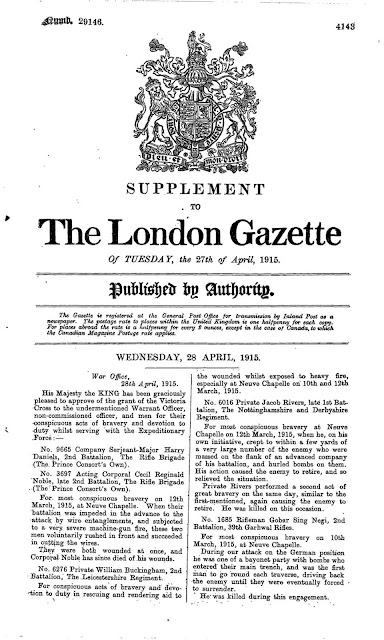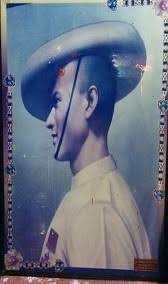The role of the Indian Army in World War has often been forgotten. Over one million Indian troops served in the war: over 70,000 were killed, and nearly that many were wounded.
Indian soldiers at Neuve Chapelle, 1915.
(Official British Military painting published in "The Great War" Ed. H.W. Wilson, 1916)
In the Battle of Neuve Chapelle, the 7th Meerut Division of the Indian Corps led the attack, suffering over 4,200 casualties.
Gabbar Singh Negi was one of those who died in the battle; he was posthumously awarded the Victoria Cross for "his conspicuous acts of bravery and devotion to duty." His body was never found, but his name is recorded on the Neuve Chapelle Indian Memorial that lists the 4,742 Indian soldiers of the war who have no known grave.
H.W. Garrod wrote a poem on the battle (published in Worms and Epitaphs, 1919). It's brevity and directness need no comment: they shape the meaning of the poem.
Tell them at home, there's nothing here to hide.
We took our orders, asked no questions, died.
 |
| captionThe Victoria Cross won by Gabar Singh Negi (left) was proudly worn by his wife Satoori (right) six decades after his death in the battle of Neuve Chapelle in 1915 |
He died aged 22 in the battle of Neuve Chapelle - one of the biggest battles that the Indians fought as a united corps. Gabar's wife, a 13-year-old child bride, wore his Victoria Cross on her sari all her life until her death in 1981. Gabar Singh Negi's VC was sent to the India Office to be sent to his closest relative, Satoori Devi, his better half. The VC was gained by his regiment which orchestrated an imitation to be sent to Devi. A letter of sympathy from Queen Mary was additionally sent to Satoori Devi wife of Gabar Singh. The award was a wellspring of pride for Gabar Singh Negi's widow, who might wear it until her passing in 1981.
Gabar Singh Negi has no known grave; his name is recorded on the Neuve-Chapelle Memorial, as Gabar Singh Negi. His name was one of those remembered for the vault of the Memorial Gates in London, revealed in 2002. The Gabar Singh Negi Fair held annually in his memory in Chamba. In 1971, the Garhwal Rifles adopted the Fair, to give it a much-needed boost. A memorial was constructed; and with the inclusion of army traditions in the ceremonies, the Fair started attracting villagers from far and near to pay their homage to this brave soldier. Every year, on 20 or 21 April (depending on the Hindu calendar), the area around the Negi Memorial in Chamba comes alive with many kiosks being set up. This is the only fair of its kind in the state. The other feature of the fair is the recruitment rally conducted by the Garhwal Rifles Regimental Centre. The villagers, especially the youths, attend this fair because of the recruitment rally. Gabar Singh Memorial was built in 1925, to honour Gabar Singh Negi who served as a Rifleman in the Garhwal Rifles. The memorial is a popular tourist attraction of Chamba. During World War I, Singh and his battalion won the battle at Flanders in Germany. After his death, he was rewarded with the highest gallantry award, the Victory Cross. The Garhwal Regiment, on every April 21, pays tribute to this brave warrior.
The saga of Negi’s bravery continues to inspire the hill folk of Uttarakhand to join Indian Army.Gabar Singh Memorial was built in 1925, to honour Gabar Singh Negi who served as a Rifleman in the Garhwal Rifles. The memorial is a popular tourist attraction of Chamba. During World War I, Singh and his battalion won the battle at Flanders in Germany. After his death, he was rewarded with the highest gallantry award, the Victory Cross. The Garhwal Regiment, on every April 21, pays tribute to this brave warrior. The saga of Negi’s bravery continues to inspire the hill folk of Uttarakhand to join Indian Army.
Gabar Singh Negi was born at Manjood village near Chamba, Tehri Garhwal district, Uttarakhand India. The region is in the Himalayas and was a part of the first Kingdom of Garhwal, Uttarakhand. He joined The Garhwal Rifles in October 1913. He was 21 years old and a Rifleman in the 2/39th Garhwal Rifles, On the flare-up of the First World War, the 39th Garhwal Rifles was among the regiments chosen for the Indian Expeditionary Force A, bound for the Western Front in France.
By October 1914, the regiment, as a major aspect of the seventh (Meerut) Division, was in the cutting edges during the First Battle of Ypres and later in the Pas-de-Calais part where it would stay until going into saving toward the finish of that year. In March 1915, the seventh Division was chosen to be engaged with the Battle of Neuve Chapelle, which required an ambush on the German lines at Neuve Chapelle.
 |
| Entry from the 2/39th Garhwal Rifles war diary for 29th April 1815, detailing the names of those from the regiment who had received gallantry awards for their actions at Neuve Chapelle. |
The 2/39th Garhwalis, played an important role in at Neuve Chapelle, and their actions were typical of the bravery shown by the Indian Corps. The units’ war diary entries of 10 March, as well as a narrative account of the battalion’s actions written up by their commanding officer (CO) DB Brockman, a few days later, give a fascinating account of the assault, and the courage and discipline of its troops. The success of the first day of the battle of Neuve Chapelle has been credited to its careful planning, the element of surprise the British had, and the accuracy of the preceding artillery bombardment. The 2/39th Garhwalis were essential to this surprise, their commanding officer having a shallow trench cut next to their ‘jumping off’ point on the Estaires – La Bassee road, to conceal them and protect them from artillery.
The attack was set to begin at 8.05am, the first two assaulting companies of the Garhwalis lying under their greatcoats in the newly cut trench. At 7.30am the preparatory artillery bombardment, designed to cut the German wire and weaken the defences of their advance trenches, started up. The 2/39th Garhwal Rifles’ diary describes this as a ‘terrific bombardment, every kind of gun being used’, making a ‘deafening’ noise. The bombardment is noted as being accurate; the German wire being ‘cut a good deal by the fire of the guns’, but it was not without mishap. Stray British shells fell short, and the German guns also replied, one shell falling close to the Garhwalis’ commanding officer, as he, his adjutant, his orderly and a man of the Infantry sat up on the British parapet watching the bombardment. The CO notes that a German high explosive shell fell close to their seat, sadly killing the orderly and solider, but the CO and adjutant were left unhurt, beyond a ‘covering of green and a mouthful of green sulphurous smoke’.
At 8.05am sharp the Garhwalis began their advance, the artillery lengthening their range so as to open up space for the men to move toward the German line. This combined with the concealment provided by the hastily cut trench next to their ‘take off’ point, allowed the German line, according to the Garhwalis’ CO to be ‘nearly reached before the enemy was fully aware of the fact and could open as hot a fire as he might have done’. Reaching the main German line, the Garhwalis met at first with little resistance, which their commander credits to his troops ‘rising without hesitation” to advance’. The unit’s war diary entry then recounts that ‘bombing and bayonet parties worked down the main [German] fire trench’ as well as communication trenches, reporting that ‘several casualties occurred here’ but that the ‘line pressed on and reached their objective'.
One of these casualties was the greatest tribute to the valour and bravery of the Garhwali men that day. Rifleman Gabar Singh Negi (often erroneously referred to as Gobar Sing Negi in contemporary British sources) led one of the bayonet parties who bombed and charged their way through the main German trench that day. Showing bravery and leadership one would usually associate with an officer, he led his comrades in charge, the London Gazette recording that he ‘was the first man to round each [German] traverse, driving back the enemy until they were eventually forced to surrender’.
Rifleman Singh Negi was sadly killed during this action, but his bravery allowed the Garhwalis to take 187 prisoners and three machine guns in their attack, the battalion quickly sending two companies forward to occupy the village of Neuve Chapelle and the Smith-Dorrien line beyond. Singh Negi was posthumously awarded the Victoria Cross for his actions – ‘For valour’ is the inscription that appears on the front of a Victoria Cross. Unfortunately few records of him survive in Britain, other than the Gazette entry for his medal and a brief mention in the April 1915 war diary of his battalion.
On 10 March 1915, during the First World War,
"For most obvious grit on 10th March 1915, at Neuve Chapelle. During our assault on the German position, he was one of a pike party with bombs who entered their fundamental channel and was the primary man to go round each cross, driving back the adversary until they were in the long run compelled to give up. He was murdered during this commitment."
— London Gazette, 28 April 1915
He was 21 years old and a Rifleman in the 2/39th Garhwal Rifles, Indian Army, when he performed the deeds at Neuve Chapelle, France which led to his being awarded the Victoria Cross. The VC, founded in 1856, was the most noteworthy honour for bravery that could be presented on a fighter of the British Empire.
-×-×-×-×-×-×-×-
गबर सिंह नेगी का जन्म उत्तराखंड भारत के तेहरी गढ़वाल जिले चंबा के पास मंजुद गांव में हुआ था। वह अक्टूबर 1 9 13 में गढ़वाल राइफल्स में शामिल हो गए। 10 मार्च 1 9 15 को, प्रथम विश्व युद्ध के दौरान, वह 21 वर्ष का था और 2/39 वें गढ़वाल राइफल्स, भारतीय सेना में एक राइफलमैन, जब उन्होंने फ्रांस के न्यूव चैपल में किए गए कार्यों का प्रदर्शन किया, जिसके कारण उन्हें विक्टोरिया क्रॉस से सम्मानित किया गया। चंबा में उनकी याद में सालाना गबर सिंह नेगी मेला आयोजित किया गया।
1 9 71 में, गढ़वाल राइफल्स ने मेला को अपनाया, ताकि इसे बहुत आवश्यक बढ़ावा दिया जा सके। एक स्मारक बनाया गया था; और समारोहों में सेना परंपराओं को शामिल करने के साथ, मेले ने ग्रामीणों को इस बहादुर सैनिक को श्रद्धांजलि अर्पित करने के लिए दूर और करीब से आकर्षित करना शुरू कर दिया।
हर साल, 20 या 21 अप्रैल (हिंदू कैलेंडर के आधार पर), चंबा में नेगी मेमोरियल के आसपास का क्षेत्र कई कियोस्क स्थापित किए जाने के साथ जीवित आता है। यह राज्य में अपनी तरह का एकमात्र मेला है। मेले की दूसरी विशेषता गढ़वाल राइफल्स रेजिमेंटल सेंटर द्वारा आयोजित भर्ती रैली है। ग्रामीणों, खासकर युवाओं, भर्ती रैली के कारण इस मेले में भाग लेते हैं।












No comments:
Post a Comment